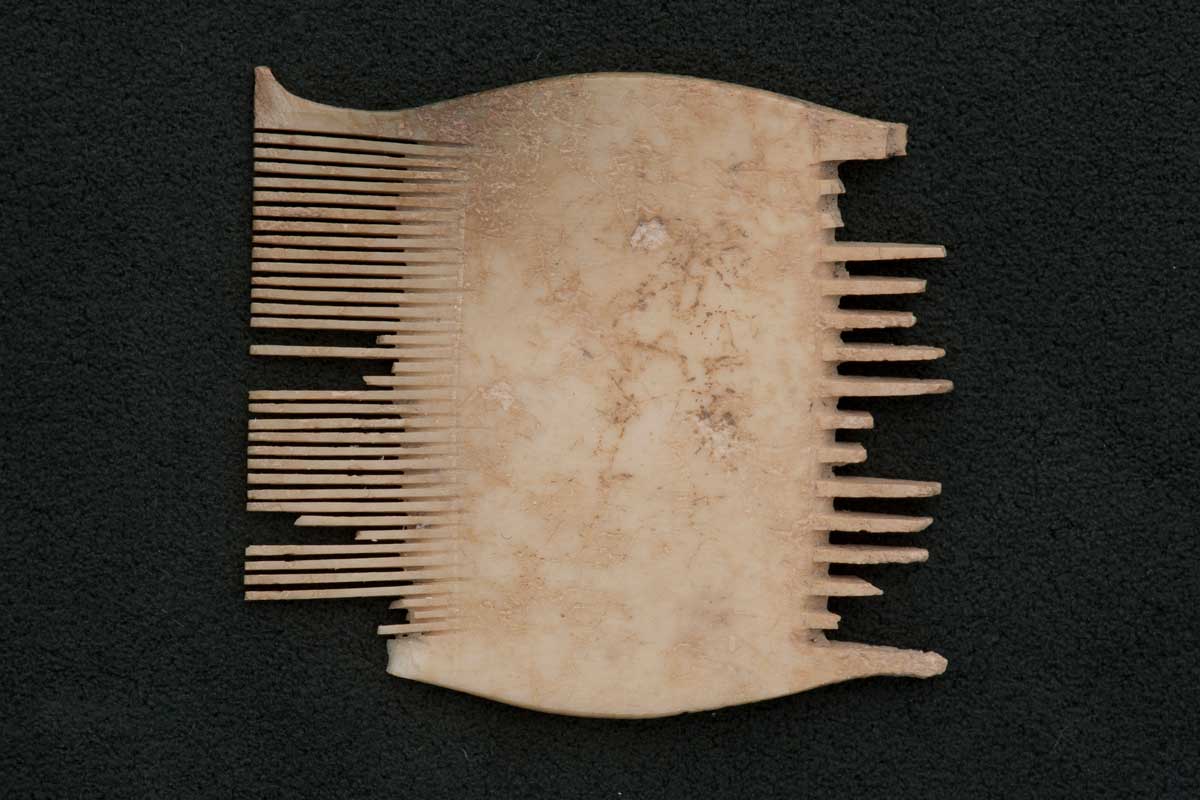Archaeology of Daily Life | Female Beauty
Double-Sided Comb
By Elizabeth Dowdle

Material: Ivory
Date/Culture: Roman
Find Spot: Unknown
Condition: Many teeth missing or broken on the coarse side of this H-shaped comb, while most on the fine side are intact.
This delicate ivory comb, small enough to fit into the palm of one’s hand, features two different sets of teeth, one noticeably broader and more widely spaced than the other, making it an ideal instrument for grooming both fine and coarse sections of hair. Because of its small size, it might also have been used as a sort of fastener, used in styling to hold the hair in the desired position. Though it is impossible to know exactly how it was used, this object’s lack of extravagant design or adornment suggests that it functioned as an object of daily use. Its H shape and convex ends are typical of Roman double-sided combs. Fashioned in full from one section of ivory, similar combs have been discovered at numerous Roman sites.
Many double-sided combs have been unearthed at Roman army camps from far-flung regions of the empire. Although some of these items might have belonged to the women in the Roman officers’ households, the large number of combs discovered at Roman camps suggests a different hypothesis. In these congested environments, where lice and other forms of contamination were common, combs would have been prized as hygienic tools, used for delousing and general grooming practices. Since most of the Roman army issued combs were made of boxwood, not ivory, it is possible that the example in our collection was intended for women’s use.
Hairdressing was part a woman’s cultus, the practice of self-cultivation and improvement, which was central to the lives of elite Roman citizens. Although both men and women strived to maintain their bodies, women naturally had more to accomplish and thus required more time and tools. Images of women in the process of having their hair styled appear on wall paintings, funerary reliefs and on ceramic vessels. These representations document the great effort required to produce the elaborate coiffures worn by Roman women. For the Romans, a woman’s ability to afford the time and manual labor necessary to have her hair styled was not only a sign of wealth, but also of her value within the household.
Many objects particular to hairdressing have been recovered from funerary and domestic contexts, including hairpins, bodkins, hair nets, and combs like the one in our collection. Much research has been conducted to discern the authenticity of the elaborate hairstyles seen in surviving portraiture and sculpture, and these tools have proven that these looks were possible with real human hair, even that which was attached to the sitter’s head. These styling tools were no doubt an important part of the mundus muliebris, i.e. items intended primarily for women’s use. A woman’s collection of cosmetic products and tools, which likely included a comb like the one in the JHUAM, was both a prized possession and a sign of her social standing.
References
Bartman, Elizabeth. “Hair and the Artifice of Roman Female Adornment.” American Journal of Archaeology: Volume 105 (2001). 1-25.
D’Ambra, Eve. Roman Women. Cambridge: Cambridge U.P. 2007.
Derks, Ton and Wouter Vos. “Wooden Combs from the Roman Fort at Vechten: The Bodily Appearance of Soldiers.” Journal of Archaeology in the Low Countries: Volume 2 (2010). 53-77.
Lefkowitz, Mary R. and Maureen B. Fant. Women’s Life in Greece and Rome. Baltimore: Johns Hopkins U.P. 1982.
MacGregor, Arthur. Bone, Antler, Ivory and Horn. Beckenham, Kent: Croom Helm Ltd. 1984.
Stephens, Janet. “Ancient Roman Hairdressing: On (Hair)pins and Needles.” Journal of Roman Archaeology: Volume 21 (2008). 111-126.